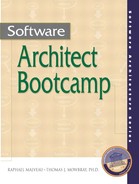9.7. Example: Reference Selling
One of the ultimate weapons in psychological warfare is the power of illusion. In this warfare we prey on human weaknesses with positive intent. Suppose we had to sell a 10-million-dollar software system (i.e., very expensive). The buying authority for such a product may not even exist entirely within the IT community of the organization; perhaps it resides in the Chairman of the Board of Directors. But even more important than influencing the Chairman will be justifying the sale to the organization, so that the executives have a clear indication of need. It's a lobbying effort on a massive scale, because no one individual needs (or can justify) the whole system, but each may benefit in his or her own way from the purchase.
This kind of salesmanship assignment is a primary activity of software architecture, as it is for software salesmen. But the need to "sell the system" may be just as great for the architect. And the situation, as we have posed it, is within the scope of the kinds of "organizational sales" that software architects participate in and sometimes lead.
The trick for making such a large sale is in the sales pitch. First, you need multiple points of contact in the organization, ideally representing multiple chains of management. We want to talk to each point of contact with the intent of achieving two key things. The highest priority is to convince them that what you are selling is what they want. Then it is important to get them to articulate that need. We will use that information later. Then you want to get additional referrals to other people in the organization. If you succeed with your first contact, you are well on your way. You have a successful sales pitch. However, it often takes three to six months to complete business on this scale.
We use the referrals to lobby additional points of contact in the organization. Remember that leaving a voicemail is not good enough. We need to get them on the phone and/or meet them in person to deliver our pitch. On the second and subsequent contacts, we use the fact that earlier contacts indicated "need" for the product in order to convince our current prospect that it's a growing wave of demand within the organization.
We are telling the customer that it's safe for him/her to support this purchase, because many other people already do. It's a done deal. It's a fait accompli. Real salesmen will stretch the truth (via careful articulation) just a bit in order to make their point. In other words, this is a form of namedropping, with a systematic intent. What's important is that we are using the power of illusion to create and consolidate demand for our product.
We are describing a systematic sales process that is used by some of the world's largest software companies, called "reference selling." The software architect should be aware of how this process works, both in order to resist its influence from the outside (if necessary), and in order to use the process to build consensus on the inside of the organization (when needed).
